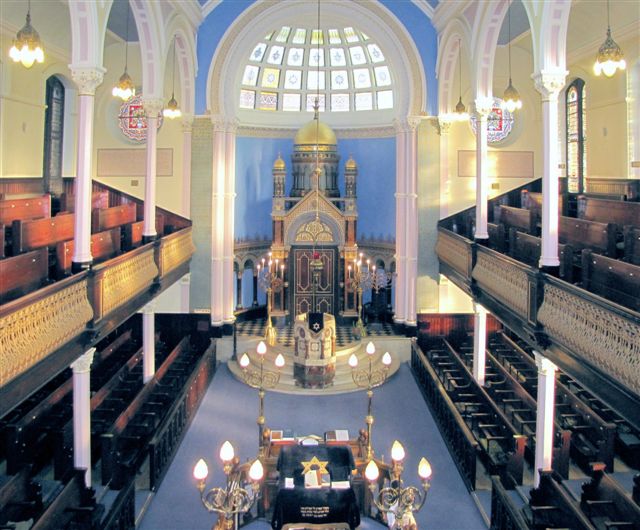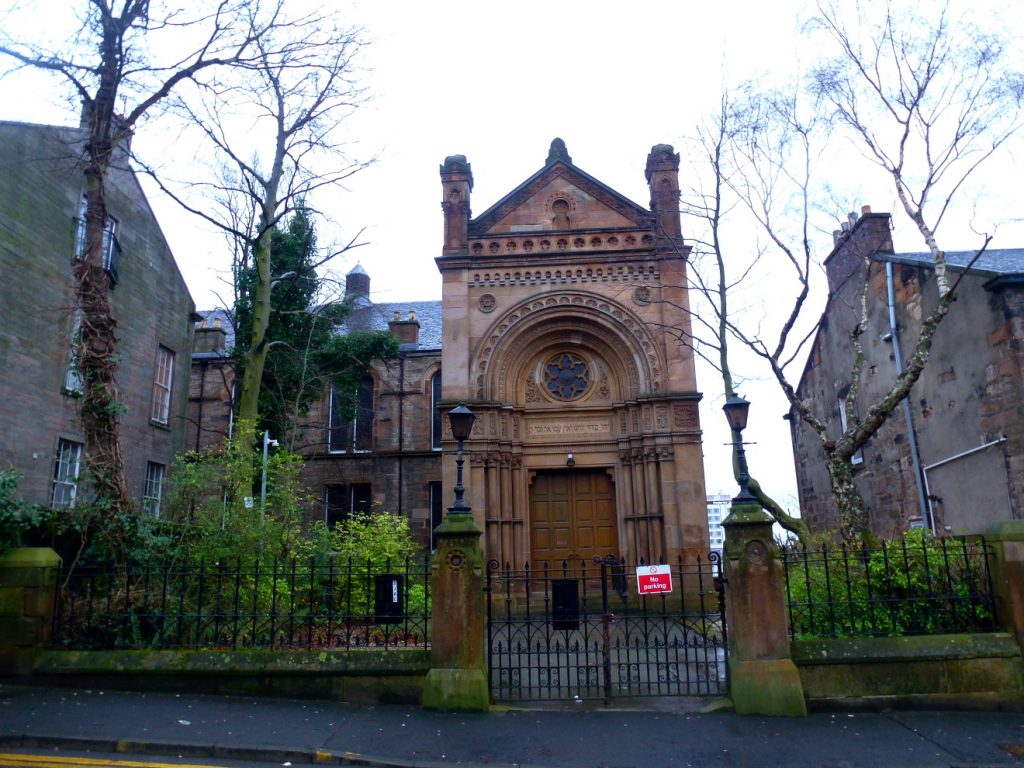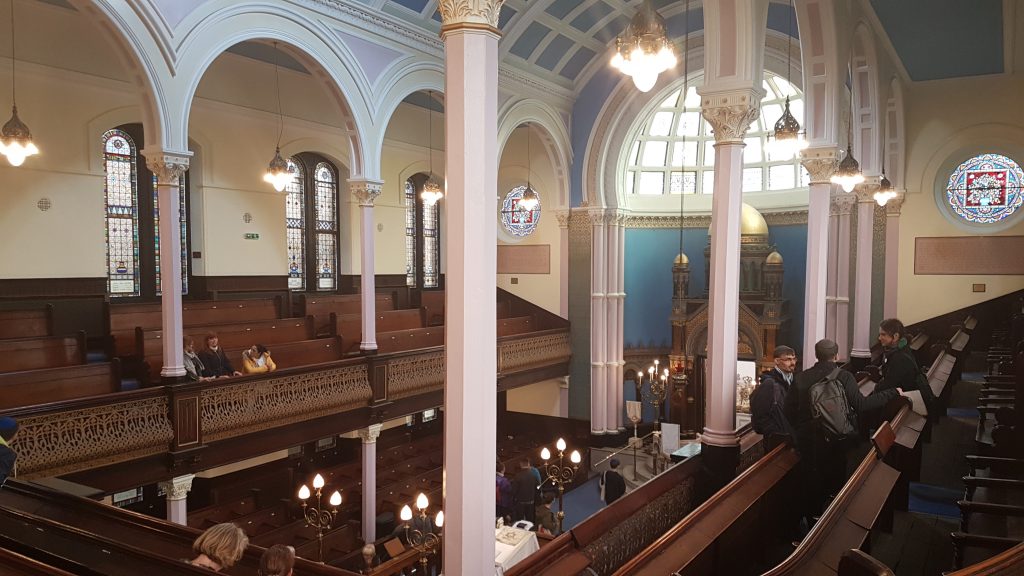
Most of Glasgow’s synagogues are in the suburbs, where the majority of the city’s 6,500 Jews now live. The oldest of them, dating from 1879, is in Garnethill .
As in the rest of the country, the first Jews to settle in Glasgow did so mainly between the end of the 18th century and the beginning of the 19th. In 1831, there were 47 Jews in Glasgow, most of them from Eastern Europe. From 1833, Moses Lisenheim, the city shohet, welcomed into his home what served as a synagogue. Two years later, the Jews bought a plot to bury the dead.
In the middle of the 19th century, 200 Jews lived in Glasgow. The Glasgow Hebrew Congregation was built in 1858. This inaugurated the construction of other synagogues in the city, mainly that of Garnethill. A development parallel to the integration of thousands of Jewish refugees from Eastern Europe, fleeing the pogroms. Some of them continued on to North America and the rest settled in Glasgow. The population evolved at this time to 4,000 Jews in 1897 and 6500 in 1902.

Glasgow experienced a great development in its Jewish life during the first six decades of the 20th century. And differed from other Scottish towns by the presence of a yeshiva and a Jewish school, Glasgow University also teaching Biblical studies and modern Hebrew. Some of the great university professors include Noah Morris, Michael Samuel and David Daiches Raphael. Note also the presence of the newspaper The Jewish Echo, a weekly founded in 1928, joined in 1965 by The Jewish Times.
If 13,400 Jews lived in Glasgow in 1969, this number fell to 6,700 in 1995, then 4,224 in 2001. There are six synagogues in Glasgow today. The Garnethill is Glasgow’s oldest operating. It was built by architect John McLeod. If you would like to learn more about the history of Scottish Jews, you can direct a request to the Scottish Jewish Archives Center located in Garnethill Synagogue. Created in 1987, it houses many objects retracing 200 years of Scottish Jewish life. Among them, more than 6000 photos and many old manuscripts, but also days, plaques, paintings and sculptures. The place is open to everyone, regularly welcoming students and researchers.

The second synagogue built and still in operation is Or Hadash . Dating from 1931, it has met with growing success for several decades. It is the only liberal synagogue in Scotland. The other four synagogues are that of Giffnock (built in 1938), then those of Netherlee, Langside and the Shul in The Park.
There are several places to eat. In particular, Mark’s Deli which is full of many products, but also the L’Chaim restaurant and the Sora’s café which adjoins the Giffnock synagogue.
Interview with Kerry Patterson, Manager of the Scottish Jewish Heritage Centre, about the Garnethill synagogue and the European Days of Jewish Culture
Jguideeurope: Could you tell us a bit more about the history of Garnethill?
Kerry Patterson: The first organised Jewish community in Glasgow can be traced to the early 1820s in the High Street. Fifty years later, the community, which by then numbered about 1000 persons, had outgrown various premises and looked to build a permanent home. The decision to build a synagogue on the corner of Garnet Street and Hill Street was made in 1875, and many members of the community then settled in this up-and-coming area.
Benjamin Simon, one of the synagogue’s trustees, set the foundation stone in 1877. Designed by John McLeod and Nathan Solomon Joseph, the first purpose-built synagogue in Scotland was opened in 1879 and soon became a landmark architectural example of the high Victorian style.

Can you tell us about the new Scottish Jewish Heritage Centre?
We launched the Scottish Jewish Heritage Centre in the Garnethill Synagogue. The Centre facilitates the sharing of information about the Category A listed building, the unique Scottish Jewish Archives Centre’s collections and aspects of Scottish Jewish history and culture. An experience enabling visitors to discover our 200-year experience of Jewish Scottish life. The Centre is a partnership project between the Scottish Jewish Archives Centre (SJAC), Garnethill Synagogue Preservation Trust (GSPT) alongside Garnethill Hebrew Congregation – all of which are based in Garnethill Synagogue.
Important funds enabled us to provide new interpretative displays, a study room housing a specialist Holocaust-era reference library, digital research resources and a school visit facility. Along that, major building restoration and renovation work in the lower level of the synagogue has improved public access to underused spaces. The new displays help the visitors understand the complicated period from 1933 to the 1950s when Scotland took in refugees fleeing Nazi persecution in Europe.
Most important, the sharing of this heritage with future generations. School students visiting will be able to use interactive learning kits, based on Holocaust-era refugee collections held in our archives. Among those resources available are the poignant experiences of refugees Dorrith Sim, Ernst Marchand and Hilda Goldwag who fled Europe, and found a safe haven here in Scotland. Students will be able to reflect on wider issues of citizenship, democracy, persecution and belonging, through the refugees’ experiences.
Visitors can find out more at www.sjhc.org.uk